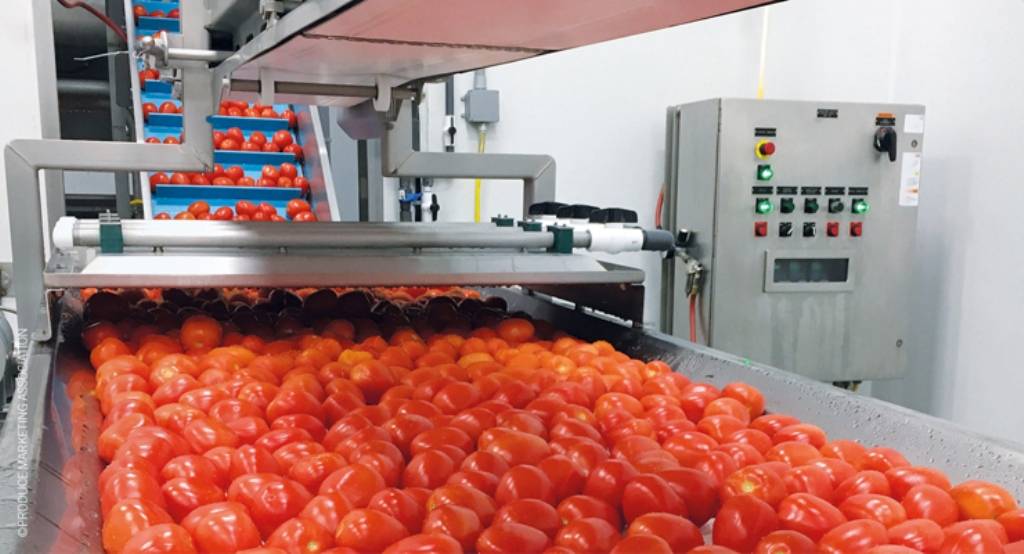
Foods processing industries now we will see the tomato activities and how good manufacturing practices are being implemented at the flow level to maintain the hygiene and sanitation.
Good manufacturing practices would ensure the product quality and its specifications. The staff when enter the factory they need to sanitize to ensure the good hygiene and sanitation so they dip their foot into potassium permanganate solution and they after hand wash has to done disinfectant. They have to wear gloves and caps on also apron.
This will prevent the foreign particles like something not connected with food product. Generally the tomatoes are transfer from the field while using the plastic grates to the factory and unloaded at the processing complex. The grates are plastic grades with enough perforations opening at the top side and bottom side so that we can have better quality when the fruits reach the factory.
The first activity the washing is done to remove the foreign particles that are sticking the fruit. The washing is done at two stages first fruit washing is done with chlorinated water. The chlorine level in the water is decided by the water test. During the washing process the diseased and rotten fruits are identified and segregated at this stage. Second washing is done with clean water to remove the dirt and also remove the rotten fruits or fruits not suitable for processing.
The fruit with good red color allowed into the processing line. We have to remove the rotten fruits from the processing line. The good fruits are transferred into the fruit mill or pulverize to the crush the heart tomato fruits.
The cold pulp is imported into the kettle attached with agitator and the kettle is a steam jacketed one. The steam is given with the help of the boiler into the cold path. The purposes of this kind of preheating is to extract the color.
The color pigments from the skin are transferred into the pulp. The level of steam is adjustable one and you could see the boiled part with constant agitation. The pulp from the preheated kettle is transferred through the bucket elevator driven by screwdriver or screw anchor and the pulp is taken up to the other equipment. That is pulp come finisher.

The crushed part with small particles fed into the pulp of Phoenicia. Where the solid particle fibre and seed are removed. The beauties without solid particles are collected at the holding tank though a pump. The collection tank is fitted with the agitator with a control panel. We can see the control temperature for heating it. The tube and tube spiral heat exchanger system which is a more sophisticated system. It is in continuous heating.
The equipment is called pasteurizer and heater. The heating is continued to get a desired level of concentration. This is not merely pasteurizing or taking out the temperature up to 85 degrees and try to remove the water to the desired level. Draw a sample from the pulp due titration process to find out the acidity of the product. The measurement of the acidity level is an indirect way of knowing the pH which decides the stability of the product.
There are specific recommendations from fruit process order a new FSSAI. The titration was carried out to find the neutralization level. The next parameter is to find out the total soluble solid called TSS. This is one of the specifications of the product. The tested sample is kept on the handle refractometer and closed to find out the value of TSS. Then the important aspects is packaging normal packaging can be done at odious cans. The flattened cans are received from the can manufactures.
The step one activity of can manufacturing is that the flattened cans are rolled through the reformer. The reformed can be taken into the next level that ass can blanch. The can blanch sure would make small impression at the top and bottom of the can. Every reformed and blanched can cans be seamed by putting lid on the lower side of the can. This is hand operated tool. After this process cans are called buildup cans.
This is neatly arranged in lock system for packaging purpose. Build up can be send through a sterilizer it is fitted with the steam. The cans be sterilized at the both inside and outside surface area. Then filling is started. The product after sterilization can be filled into the cans through a manually operated butterfly valve.
The temperature of pulp is 85 degree. We should not fill the prim level because we need some headspace after the cooling period. After filling litters placed on the top of the can and then moved into the ceiling section. After ceiling takes retorting section. The greatest fixed width hoist rope by suing the high straw the whole can are lifted and put into four open retort containers for hot water treatment.
This process give proper sterilization and kill all microorganism present inside the can pulp. It’s take a time for 20 – 30 minutes depending on the product. Normally temperature range is 80 – 90 degrees. After the shorting the cans are kept in cold water tank to reduce the temperature gradually.
The product cooling operation takes 45 minutes to 1 hour. Once the operation is over the water at the tank is taken out to the cooling tower and recycled backed to the cooling tank. The lifting and hoisting operation is remotely operated and can are dried out at this stage. Then after removed water particles from the cans otherwise there may cause the rusting. It can transfer to the storage room.
Yogesh Kumar1, Kipoo Kiran Singh Mahilang2, Navneet Khare1
1 Department of Food Processing & Technology, B U, Bilaspur, CG, India.
[email protected], [email protected]
2Department of FMP, SVCAET & RS IGKV, Raipur, CG, India
[email protected]
















